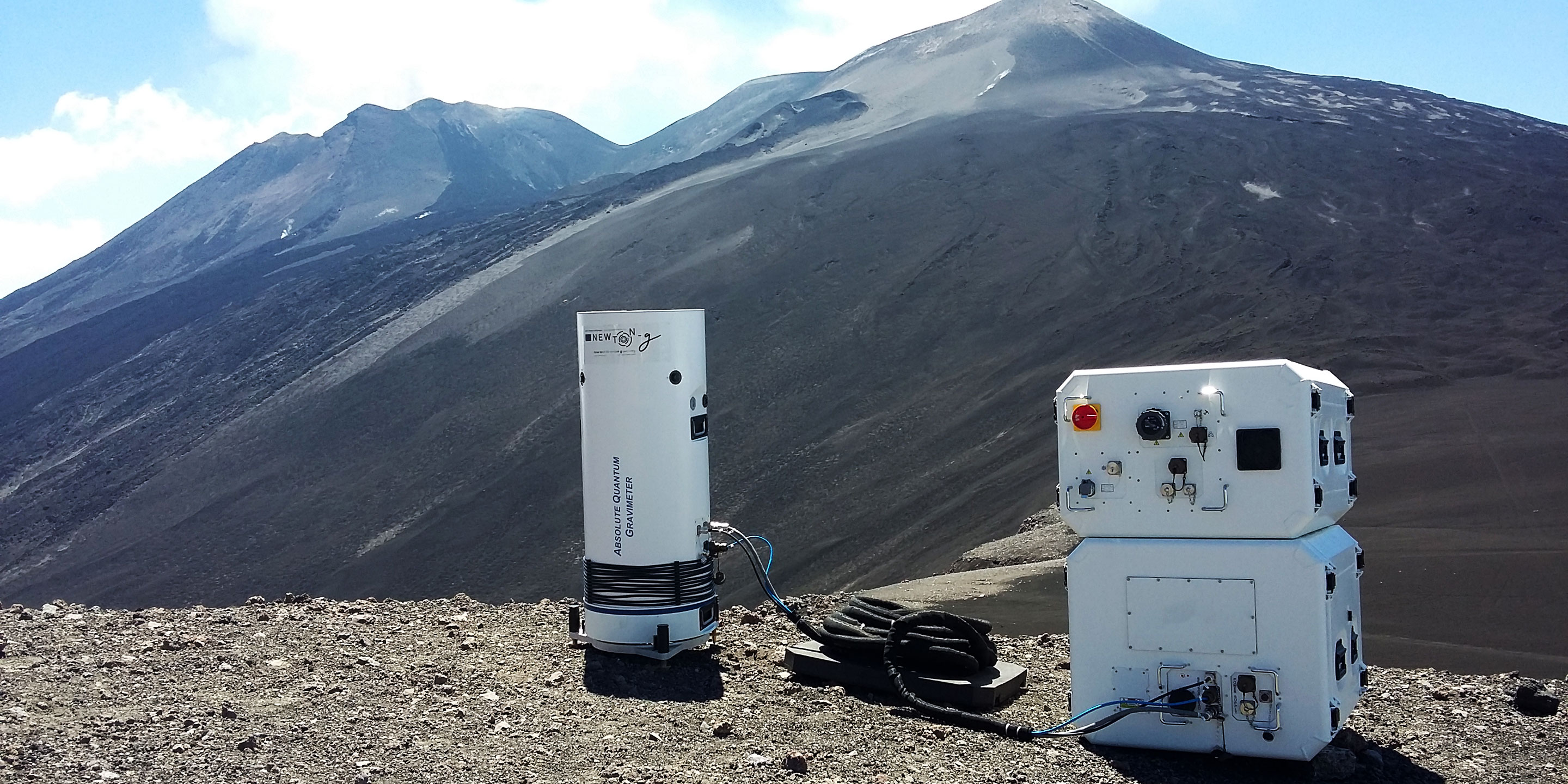- Photonics & Space
A year-long field campaign on Mount Etna to prove the Absolute Quantum Gravimeter value for volcanology


High-precision gravity measurements using Quantum Technologies and laser-cooled atoms
A gravimeter is a device that can measure the gravity field on Earth. Gravity is an acceleration, characterizing the free fall of a given object in meters per second square (m.s-2). At a given location, its value depends on the distribution of nearby masses, and isub-surface density inhomogeneities give rise to small variations of the local gravity value in space or in time. The ability to measure these fluctuations with high precision finds applications in geophysics, reservoir monitoring, geodesy, metrology and sub-surface imaging for civil engineering. With its Absolute Quantum Gravimeter, iXblue offers an outstanding precision for the gravity measurement (at the level of 10-8 m.s-2, which corresponds to approximately one part in 109 of the standard Earth gravity g=9.8 m.s-2).
Absolute gravity meters measure the acceleration undergone by a free-falling test-mass. The most common technology relies on optical interferometry, where the position of a mirror in free-fall is tracked optically. However, these instruments are not well suited for continuous measurements in field conditions, in particular because of the presence of moving mechanical parts under vacuum that make them quite fragile, and because they are complex to operate.
iXblue Absolute Quantum Gravimeter (AQG) uses an ensemble of laser-cooled rubidium atoms as a test mass. Taking advantage of the wave-particle duality, quantum matter-wave interferences are used to measure the acceleration of the atoms as they fall and to track variations of the value of gravity over time. This technique is one of the ballistic free-fall methods proclaimed by the International Bureau of Weights and Measures (BIPM) as an official primary method for the measurement of gravity.
A turn-key transportable and easy-to-operate quantum sensor on top of Etna Mount
The goal of the European project NEWTON-g, led by the Italian National Institute of and funded by the European Commission, is to place a network of gravity sensors on Etna Mount, in Italy and provides high-quality data. It serves as a high-performance reference, while the rest of the network will be composed of many small, less accurate but also less consuming gravimeters based on MEMS. Each gravimeter will offer the equivalent of a pixel for a mesh coverage of the volcano’s depths. Measuring the variations of the gravity in such a way will allow to resolve density and provide real-time images of gravity changes.
Using the data from the array of gravimeters, geophysicists will be able to constrain volcanological models and get a better understanding of processes leading to eruptions. With respect to other technologies, the AQG has proven its ability to provide high resolution measurements in the challenging environment of an active volcano. It is in particular highly robust against seismic noise coming from the volcano and can provide continuous absolute gravity measurements while being remotely operated. This proves to be of high importance given the difficult access conditions on Mt Etna. The AQG is a turn-key solution for geophysicists, allowing a high level of performance with no need to recalibrate the system. Being able to collect data without interruptions on timescales ranging from months to years is very important for understanding complex geophysical systems. At this stage, iXblue solution has no existing commercial industry-grade competitor able to provide all these features in a single instrument.
The technical results of the AQG within the NEWTON-g project on Mount Etna are currently under evaluation for scientific publication. They conclude on the true advantage of the AQG solution for such a long-term field mission. Recent data has also shown the robustness of the AQG during eruptive events on the volcano. iXblue photonics solutions are at the heart of this success. The AQG embarks sub-components developed by iXblue, like the Intelligent Laser Systems (ILS), the iMOB series and soon the specialty fiber optics. The ILS system relies on the use of lasers operating at 1560 nm. This approach therefore gives access to a wide variety of high performance fibered optical components, originally developed for high-bit-rate optical communication systems.
Quantum gravity sensors like the AQG can be used for any applications where mapping the underground mass distribution is relevant. This applies to hydrology and seismology, as well as civil engineering projects to detect voids, sink holes, tunnels and cavities. iXblue quantum gravimeters are already being used in other fields than geophysics – for example, with the French Ministry of Defence to supply shipborne quantum gravimeters in the frame of a joint project with ONERA, the French national aerospace research center.


